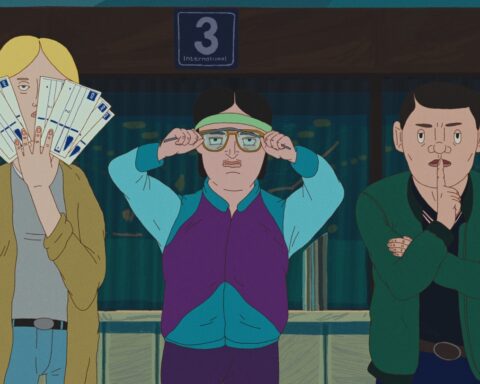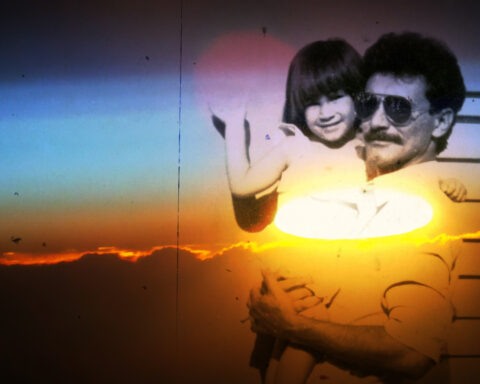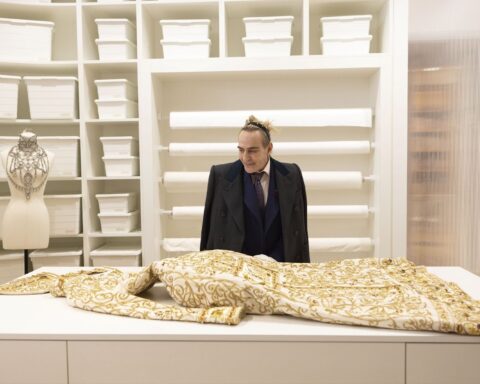Talking about Elephant’s Dream, his visually striking, thematically unsettling, and at times comical debut doc feature, Belgian director Kristof Bilsen says that “people are really grateful to see something different than the films they know about the Congo. Minerals, lootings, horror stories, rebels, raped women, etc. Basically a country that’s fucked and failed. In my film, they see dignity, they see poetry, they see humor. It’s a tragedy, but there’s also a lightheartedness to it.”
Throughout the doc, Bilsen crosscuts between three main characters trying to survive parallel situations that are as absurd as the conditions in a Beckett play. Often we hear the characters’ voices in internal monologues that bring viewers into intimate contact with their thoughts and emotions. Although the movie is loaded with political implications about the Democratic Republic of Congo (DRC), Bilsen didn’t want to see any declaiming in it.
At one point, the director found a woman he thought could be one of the three protagonists, but she “wanted to tell the audience what the Congolese need. Wire money to the following bank account number. I don’t want to be told what I have to think,” Bilsen continues during a Hot Docs interview. “There’s too many opinions these days, too much pro and contra. I prefer to allow the audience to draw themselves into the material, to almost walk around in the shots.”
The movie opens on a very long take as a marching band crosses and re-crosses the perfectly composed frame. The shot allows for a gradual transition into the film’s world. At the same time, there is something faintly comical about the image, like a deadpan observation of absurdity from Jacques Tati.
The three locations in Elephant’s Dream are typical of the DRC’s decaying infrastructure: a post-office, a train station, and the only fire station in Kinshasa, which a few years ago was partly destroyed by a fire.
“So many decades after colonial rule, and Mobutu rule, and the crisis and the lootings,” says Bilsen, “all the state owned institutions are crumbling down, and it is not a priority apparently to build an infrastructure.”
An attractive, spiritually inclined woman called Henriette seems to be the only employee in the big empty post-office which no-one uses because they don’t believe their mail will ever be delivered. Bored, frustrated, but determined, Henriette sits behind a mesh screen thinking about her predicament and trying to find a way out. Like all the government employees, she is paid erratically. Sometimes, she and her colleagues get remunerated for work they did two years ago.
Meanwhile, melancholy, soulful Simon guards a railway station with his friend Nzai. Simon sits on a chair at the entranceway almost Buddha-like. Weeds flourish on the tracks, gving sustenance to the local goats. Maybe one day, Simon hopes, a train will pass. In one of the film’s drily funny moments, Nzai threatens to arrest a student who crosses the virtually abandoned tracks.
The most outspoken of the three characters is fireman Lt. Kasuuga Kashunga, who complains that the profit crazy Chinese entrepreneurs who built new roads did not install fire hydrants. His boots were made in CANADA, he says sardonically. They were worn out by a white man; now it’s his turn. Kashunga says that he puts up with his bosses’ daily contempt because during colonial days, the Congolese learned submission to powerful masters.The fireman’s angry frankness confirms the sense of simmering defiance that permeates the film.
Some viewers have told Bilsen that his characters are “passive and apathetic. But make no mistake about it,” he says, “there is a lot of rebellion, and there is a lot of initiative. We have this sugarcoated idea of revolution. Ah, the Arab Spring.
“The thing I like so much, fingers crossed, in Kinshasa is it that they wait. They know revolution is little steps here and little steps there. You have to play with the system. You cannot all go out in the streets although they did that in January. There is hope in this film, massive hope.”
As for the film’s aesthetic approach, Bilsen says it was “conceptualised” by his doc’s subject matter. “I felt that the locations are in themselves characters. And they play upon the characters. The crumbling down post office building and fire station. The beautiful trees at the train station. I am really drawn to this kind of more visceral documentary.”
Given Elephant Dream’s content, was there opposition to the production?
In fact, shooting in the DRC “was surprisingly easy,” Bilsen recalls. “At first, they were very secretive about everything and controlling. So you have to be a good boy and follow procedures, get proper accreditation, and so on.” Eventually, procedures took less and less time. Bilsen also points out that the movie wasn’t a potentially objectionable foray into the heart of darkness, “the horror, and the horror.”
As for the finished film, it’s not only about the Congo, “it’s about us. Boredom is universal, anxieties are universal, humour is universal. How do you dignify yourself in a situation that really is challenging? How do you go about it?”
An ambitious multi-leveled project, Elephant’s Dream pleasurably fuses the characters’ almost meditative internal monologues and the film’s static, contemplative images in slowed-down, pensive editing rhythms. At the same time, it relays political and social messages about life in a particular dysfunctional society, which may serve as a cautionary tale to audiences in other parts of the world, including North America.








